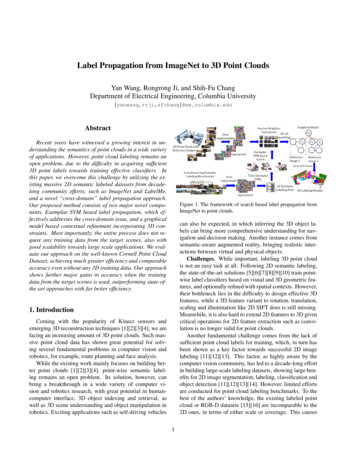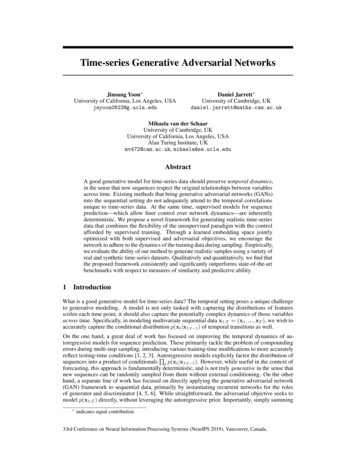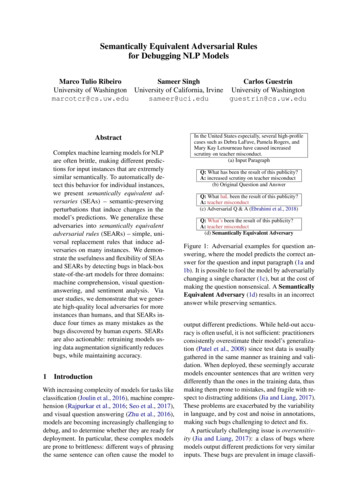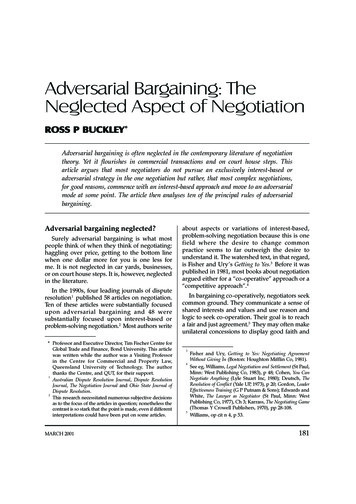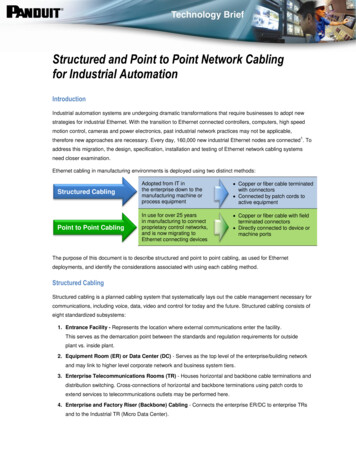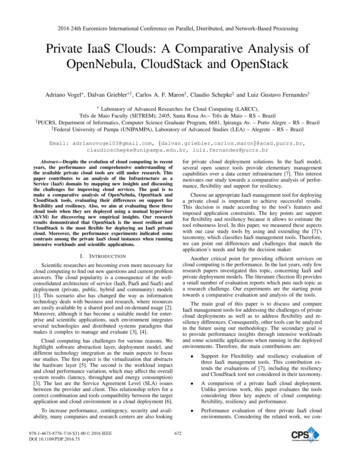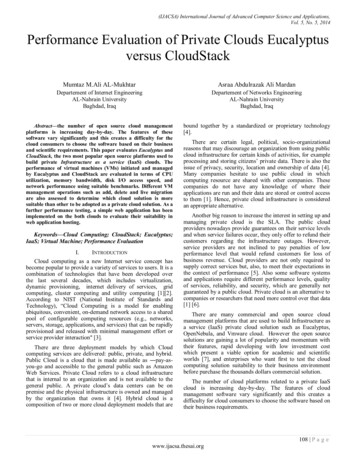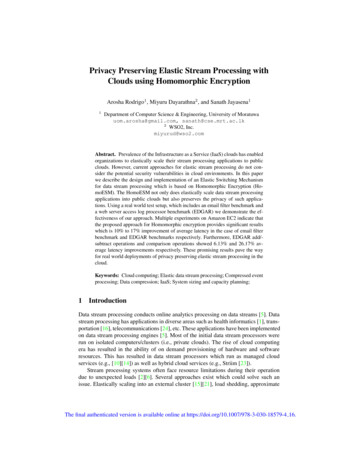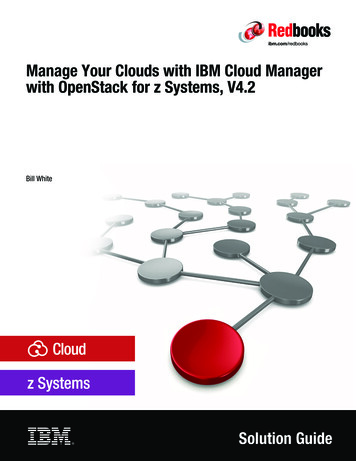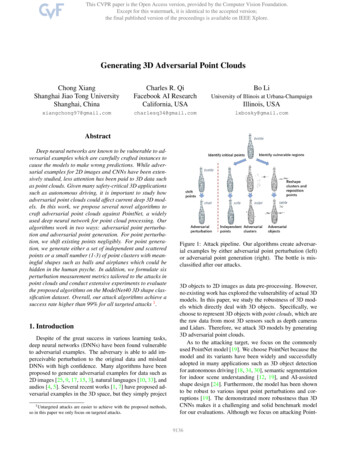
Transcription
Generating 3D Adversarial Point CloudsBo LiChong XiangShanghai Jiao Tong UniversityShanghai, ChinaCharles R. QiFacebook AI ResearchCalifornia, USAUniversity of Illinois at mail.comlxbosky@gmail.comIllinois, USAAbstractDeep neural networks are known to be vulnerable to adversarial examples which are carefully crafted instances tocause the models to make wrong predictions. While adversarial examples for 2D images and CNNs have been extensively studied, less attention has been paid to 3D data suchas point clouds. Given many safety-critical 3D applicationssuch as autonomous driving, it is important to study howadversarial point clouds could affect current deep 3D models. In this work, we propose several novel algorithms tocraft adversarial point clouds against PointNet, a widelyused deep neural network for point cloud processing. Ouralgorithms work in two ways: adversarial point perturbation and adversarial point generation. For point perturbation, we shift existing points negligibly. For point generation, we generate either a set of independent and scatteredpoints or a small number (1-3) of point clusters with meaningful shapes such as balls and airplanes which could behidden in the human psyche. In addition, we formulate sixperturbation measurement metrics tailored to the attacks inpoint clouds and conduct extensive experiments to evaluatethe proposed algorithms on the ModelNet40 3D shape classification dataset. Overall, our attack algorithms achieve asuccess rate higher than 99% for all targeted attacks 1 .1. IntroductionDespite of the great success in various learning tasks,deep neural networks (DNNs) have been found vulnerableto adversarial examples. The adversary is able to add imperceivable perturbation to the original data and misleadDNNs with high confidence. Many algorithms have beenproposed to generate adversarial examples for data such as2D images [25, 9, 17, 15, 3], natural languages [10, 33], andaudios [4, 5]. Several recent works [1, 7] have proposed adversarial examples in the 3D space, but they simply project1 Untargeted attacks are easier to achieve with the proposed methods,so in this paper we only focus on targeted attacks.Figure 1: Attack pipeline. Our algorithms create adversarial examples by either adversarial point perturbation (left)or adversarial point generation (right). The bottle is misclassified after our attacks.3D objects to 2D images as data pre-processing. However,no existing work has explored the vulnerability of actual 3Dmodels. In this paper, we study the robustness of 3D models which directly deal with 3D objects. Specifically, wechoose to represent 3D objects with point clouds, which arethe raw data from most 3D sensors such as depth camerasand Lidars. Therefore, we attack 3D models by generating3D adversarial point clouds.As to the attacking target, we focus on the commonlyused PointNet model [19]. We choose PointNet because themodel and its variants have been widely and successfullyadopted in many applications such as 3D object detectionfor autonomous driving [18, 34, 30], semantic segmentationfor indoor scene understanding [12, 19], and AI-assistedshape design [24]. Furthermore, the model has been shownto be robust to various input point perturbations and corruptions [19]. The demonstrated more robustness than 3DCNNs makes it a challenging and solid benchmark modelfor our evaluations. Although we focus on attacking Point19136
Net, we expect our attacking algorithms and evaluation metrics extensible to more 3D models.As the input to PointNet, a point cloud is a 3D geometricdata structure that has the advantages of simple representation and low storage requirement. However, it is challenging to generate adversarial point clouds given its special properties. The point cloud’s irregular format has madeexisting attack algorithms designed for 2D images unsuitable: 1) In raw point clouds with XY Z, there are no “pixelvalues” positioned in a regular structure that can be slightlymodified; 2) The search space for generating new adversarial points is very large, as points can be added to arbitrarypositions; 3) The commonly used Lp norm measurementin 2D images to bound perturbations does not fit for pointcloud data with irregularity and varying cardinality.To the best of our knowledge, we are the first to extendadversarial attack research to the irregular point cloud data,by addressing aforementioned challenges. We propose several novel attack methods for mainly two types of adversarial attacks on point clouds: adversarial point perturbationand adversarial point generation which are unnoticeable tohuman or hidden in the human psyche. The attack pipelineis illustrated in Figure 1.For adversarial point perturbation, we propose to shiftexisting points negligibly. We optimize the perturbationvector under the commonly used Lp norm constraint. Ourexperiments show that we are able to craft unnoticeable adversarial point clouds with 100% success rate given an acceptable perturbation budget.For adversarial point generation, We propose to synthesize and place a set of independent points or a limited number of point clusters close to the original object. In particular, we search for “vulnerable” regions of objects and optimize the positions of points and the shapes of the clusters.In total, we have three kinds of generated points, namelyindependent points, adversarial clusters (points in genericshapes such as balls), and adversarial objects (points in object shapes such as mini airplanes), shown in the right threecolumns in Figure 1. We constrain the generation by theirsizes, their distances to the object surface as well as howmany shapes we place.Our attacks achieve 100% success rate for scattered adversarial points, 99.3% for adding three adversarial shapes,98.2% for two, and 78.8% for one.Furthermore, in Section 6.4 we discuss the transferrability of our 3D adversarial point clouds as well as the possibility to combine PointNet with CNNs to defense attacksin images. Sample code and data is available at https://github.com/xiangchong1/3d-adv-pc to support further research.To summarize, the contributions of this paper can besummarized as follows: We are the first to generate 3D adversarial examplesagainst 3D learning models and provide baseline evaluations for future research. Specifically, we chooserepresentative point cloud data and PointNet model forour evaluations. We demonstrate the unique challenges in dealing withirregular data structures such as point clouds and propose novel algorithms for both adversarial point perturbation and adversarial point generation. We propose six different perturbation metrics tailoredto different attack tasks and perform extensive experiments to show our attack algorithms can achieve a success rate higher than 99% for all targeted attacks. We provide robustness analysis for 3D point cloudmodels and show that analyzing properties of different 3D models sheds light on potential defenses for 2Dinstances.2. Related WorkPoint Clouds and PointNet. Point clouds are consisted ofunordered points with varying cardinality, which makes ithard to be consumed by neural networks. Qi et al. [19] addressed this problem by proposing a new network calledPointNet, which is now widely used for deep point cloudprocessing. PointNet and its variants [20, 26] exploit asingle symmetric function, max pooling, to reduce the unordered and varying length input to a fixed-length globalfeature vector and thus enables end-to-end learning. [19]also tried to demonstrate the robustness of the proposedPointNet and introduced the concept of critical points andupper bounds. They showed that points sets laying betweencritical points and upper bounds yield the same global features and thus PointNet is robust to missing points and random perturbation. However, they did not study the robustness of PointNet against adversarial manipulations, whichis the main focus of this paper.Adversarial Examples. Szegedy et al. [25] first pointedout that machine learning models such as neural networkswere vulnerable to carefully crafted adversarial perturbation. An adversarial example which appears similar to itsoriginal data can easily fool the neural networks with highconfidence. Such vulnerability of machine learning models has raised great concerns in the community and manyworks have been proposed to improve the attack performance [9, 17, 15, 3, 16, 29, 28] and search for possibledefense [2, 14, 31, 21, 22, 32]. The state-of-the-art attackalgorithm, optimization based attack [3], defines an objective loss function which measures both attack effectivenessand perturbation magnitude, and uses optimization to find anear-optimal adversarial solution. However, the algorithmonly deals with 2D data. Several recent works [11, 1, 7]also study the adversarial examples in the physical world.However, these works only project physical objects to 2D9137
images and do not study models which directly deal with3D objects. To the best of our knowledge, we are the firstto generate adversarial examples for 3D machine learningmodels.3. Problem FormulationPoint Cloud Data. A point cloud is a set of points whichare sampled from object surfaces. A data record x Rn 3corresponds to a point set of size n, where each point isrepresented by a 3-tuple (x, y, z) coordinate. One most important characteristic of point cloud data is its irregularity(a point cloud is not defined on a regular grid structure),which makes it hard to adapt existing attacking algorithmsfrom 2D images. Moreover, we are able to add points atany positions in the 3D space while we cannot add pixelsin 2D images. However, such lack of constrain results inan extremely large search space for generative adversarialexamples. New attack algorithms should be proposed to address the above problems.Targeted Adversarial Attacks. In this paper, we only focus on targeted attacks against 3D point cloud classificationmodels. It is flexible to extend our algorithms to other taskslike attacking segmentation models.The goal of targeted attacks is to mislead a 3D deepmodel (e.g., PointNet) to classify an adversarial example asa selected target class. Formally, for a classification modelF : X Y, which maps an input x X Rn 3 to itscorresponding class label y Y Z, an adversary has amalicious target class t′ Y. Based on a perturbation met′ric D : Rn 3 Rn 3 R, the goal of the attack is to find′a legitimate input x′ Rn 3 which:min D(x, x′ ),s.t. F(x′ ) t′(1)Note that, for point cloud data, n does not necessarily equalto n′ .As mentioned in [3], directly solving this problem is difficult. Therefore, we reformulate the problem as gradientbased optimization algorithms:min f (x′ ) λ D(x, x′ )(2)Here f (x′ ) (max′ (Z(x′ )i ) Z(x′ )t′ ) is the adveri6 tsarial loss function whose output measures the possibilityof a successful attack, where Z(x)i is the ith element ofthe logits (the input of softmax layer) and (r) representsmax(r, 0). By optimizing over Equation 2, we aim to searchfor adversarial examples with least 3D perturbation.Attacking Types. In this paper, we consider two different types of attacks in point clouds 2 : adversarial point per-turbation and adversarial point generation. In perturbationattacks, we modify existing points by shifting their XY Zpositions with adversarial jitters such that a point xi R3in the point cloud x becomes x′ i xi δi , for i 1, ., nwhere δi R3 is the perturbation to the i-th point. Ingeneration attacks, we generate a set of adversarial pointsz {zi i 1, ., k} (or z Rk 3 as an array representation of it) where each zi R3 is a new point in additionto the existing point cloud x. Then the union of the original points and adversarial points are input to the model:x′ x z, or in the array representation x′ R(n k) 3through array concatenation (thus n′ n k). This manner of attacking is very new and vastly different from attacks in images, because we cannot generate new pixels ina fix-sized image.4. Adversarial Point PerturbationIn this section, we focus on the first and the simpler typeof point cloud attack: adversarial point perturbation. Sincefor perturbation we have correspondences between the original points and the perturbed ones, we can simply use Lpnorm to measure the distance between the two clouds.Lp Norm. The Lp norm is a commonly used metric for adversarial perturbation of fixed-shape data. For the originalpoint sets S and corresponding adversarial set S ′ , the Lpnorm of the perturbation is defined as:Xp 1(3)(si s′i ) ) pDLp (S, S ′ ) (iwhere si is the ith point coordinate in set S, and s′i is itscorresponding point in set S ′ .We can directly use Equation 2 to generate the adversarial perturbations {δi }ni 1 , by optimization with the L2 normdistance to bound the perturbation.5. Adversarial Point GenerationBesides perturbing existing points, another general typeof attacking strategy is to generate new adversarial pointsto mislead the 3D model. Among the ways to generate newpoints, a simple approach is to add arbitrary number of independent points (Section 5.1), ideally close to the objectsurface so that they are unnoticeable 3 .On the other hand, we consider a more challenging attack task where the adversary is only able to add a limitednumber (1-3) of adversarial shapes (Section 5.2 and Section 5.3), as either generic primitive shapes such as balls ormeaningful shapes such as small airplane models. The taskis challenging since points can only be added within smallregions of the 3D space and the points of original objectremain unchanged. The goal of this attack is to generate2 To guarantee the points can still cover the object surface, we do notallow an adversary to remove points.3 How9138to realize this attack in real world is still a question though.
adversarial point clusters that are plausible so they cloud behidden in the human psyche.In the following subsections, we will introduce metricsand our attacking algorithms to generate adversarial individual points, as well as two kinds of adversarial shapes:adversarial clusters and adversarial objects.5.1. Generating Adversarial Independent PointsIn this section, we focus on the attack of generating (unnoticeable) independent points. Note that when adding newpoints to the original point clouds, we have to deal withdata dimensionality changes. We first introduce metrics thatmeasure the deviation of adversarial points to the originalone and then desrcribe our attack algorithm.5.1.1Perturbation MetricsHausdorff Distance. Hausdorff distance is often used tomeasure how far two subsets of a metric space are fromeach other. Formally, for an original point set S and itsadversarial counterpart S ′ , we define Hausdorff distance as:2DH (S, S ′ ) max′ min kx yk2y S x S(4)Intuitively, Hausdorff distance finds the nearest originalpoint for each adversarial point and outputs the maximumsquare distance among all such nearest point pairs. We do2not include the term max min′ kx yk2 since we do notx S y Smodify the original object S.Chamfer Measurement.4 Chamfer measurement [8] is asimilar perturbation metric as Hausdorff distance. The difference is Chamfer Measurement takes the average, ratherthan the maximum, of the distances of all nearest pointpairs. The formal definition is as follows:1 X2DC (S, S ) min kx yk2x SkS ′ k0′′5.1.2Attacking AlgorithmDirectly adding points to the unconstrained 3D space is infeasible due to the large search space. Therefore we proposean initialize-and-shift method to find appropriate positionfor each added point:1. Initialize a number of points to the same coordinatesof existing points as initial points.2. Shift initial points via optimizing Equation 2 and output their final positions.During the optimization process, some initial points areshifted from their initial positions and “added” to the original objects as adversarial points. The others that are barelyshifted do not change the shape of the object, and thus canbe discarded as points-not-added.To make the optimization more efficient, we propose toinitialize points to the positions of “critical points” of thetarget. Critical points are like key points or salient pointsin a 3D point cloud. In PointNet specifically, they can becomputed by taking the points that remain active after themax pooling [19], which means they are at important positions that determine the object category. Adversarial pointsaround these critical positions are more likely to change thefinal prediction.We use Hausdorff and Chamfer measurements as the perturbation metrics D for this attack because they are more capable of measuring how unnoticeable the adversarial pointclouds of different dimensionality are.5.2. Generating Adversarial Clusters(5)y SNumber of Points Added. We also want to measure thenumber of points added in our attack, by counting pointswhose distances from the object surface is above a certainthreshold. Formally, for an original point set S, the generated point set S ′ , and a threshold value Tthre , the number ofpoints added is defined as:X [min kx yk2 Tthre ] (6)Count(S, S ′ ) y S ′D in Equation 2 due to its incompatibility with gradientbased optimization algorithms, but is reported as an additional performance metric.x Swhere [·] is the indicator function whose value is 1 whenthe statement is true and 0 otherwise. Note that the numberof points added is not optimized as the perturbation metric4 We name it as “Chamfer measurement” since this perturbation metricdoes not satisfy triangle inequality, which means it does not satisfy thedefinition of distance.For adversarial clusters, we aim to minimize the radiusof the generated cluster so that they look like a ball attachedto the original object and will not arouse suspicion. In addition, we also encourage the cluster to be close to the objectsurface. To satisfy these two requirements, we introduce theperturbation metrics used as follows.5.2.1Perturbation MetricsFarthest Distance. If the farthest pair-wise point distancein a point set is controlled within a certain threshold, thepoints in this set are able to form a shaped cluster. Formally,we define farthest distance of a point set S as:Dfar (S) max kx yk2x,y S(7)Chamfer Measurement. Besides encouraging point cluster to form within a small radius, we may also want to push9139
the added clusters towards the surface of the object. Therefore, we also include the Chamfer Measurement (definedin Equation 5) as our perturbation metric and optimizationobjective.Number of Clusters Added. Similar to the number ofpoints added in the unnoticeable adversarial point cloudgeneration, the number of clusters added also serves asan additional metric for attack performance, which is hardbounded to 1-3 in our experiments.5.2.2Attacking AlgorithmBefore going into the details of generation algorithms, weneed to reformulate Equation 2 as follow:XDfar (Si ) µ · DC (S0 , Si ))(8)min f (x′ ) λ · (iwhere i {1, 2, . . . , m}, S0 is the original object, Si isthe ith adversarial point cluster, m is number of adversarialclusters, and µ is the weight used to balance the importancebetween Farthest Distance loss and Chamfer Measurementloss. Here we abuse the notation a little to use D to denote′both mappings Rn 3 Rn 3 R and Rn 3 R.Generating adversarial clusters is a special case ofadding adversarial point clouds, so we can adopt theinitialize-and-shift method used. However, unlike independent point generation, we have to constrain the added pointsclustered to be within small regions. As points are likely toget stuck in their initialized vicinity due to the ubiquity oflocal-minima, we need a more efficient initialization methods for adversarial clusters generation.We try to leverage the idea of “vulnerable regions” forinitialization. For formatted data like 2D images, it is common to impose a L1 constraint to encourage th
point clouds and conduct extensive experiments to evaluate . In raw point clouds with XYZ, there are no “pixel values” positioned in a regular structure that can be slightly . ity of our 3D adversarial point clouds as well as the pos-
